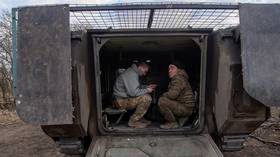Michigan farmer finds massive mammoth skeleton, donates it to university (VIDEO)
An American farmer who excavated a mammoth skeleton from his land last week decided to donate the find to the University of Michigan. The mammoth’s bones could be up to 15,000 years old. The discovery was made during routine digging for drainage.
The mammoth’s remains were discovered as Jim Bristle was installing a drainage pipe at his Chelsea-area soybean farm in Michigan last Thursday.
At the beginning, giant ribs were dug up. After realizing the scale of the find, Bristle called the University of Michigan and Dan Fisher, a professor of paleontology and director of the University’s Museum of Paleontology.
Fisher arrived along with his team to complete the excavation, which found rib bones, vertebrae, tusks, pelvic bones, and a mostly-intact skull. The professor called the discovery one of the top ten most significant finds in Michigan history and said the mammoth would be named the Bristle Mammoth, after the farmer.
University researchers have concluded that the mammoth is a hybrid between a woolly mammoth and a Columbian mammoth. The bones could be anywhere between 11,700 and 15,000 years old.
A Michigan Farmer Found a Near-Complete Mammoth Skeleton in His Field http://t.co/YaAdgJ6BZ0pic.twitter.com/BkEudnqM8K
— PaleoAnthropology+ (@Qafzeh) October 2, 2015Being so large, Bristle was not sure what to do with the skeleton and so he decided to donate it to the university where it can be looked at by all. “I’d like it to go to a place where more people can see it and we can learn more about history from it,” he told MLive. “Really it’s just the right thing to do.”
READ MORE: 126,000-year-old pre-woolly mammoth skeleton found in Siberia (PHOTOS)
“Well, the wife said we’re not hanging it over the mantle,” he added. “And I don’t think there’s a buck pole big enough for it.”
Fisher was ecstatic with the idea, adding that he hopes to display it at the university's Museum of Natural History. The whole skeleton is still at the farm and the professor’s team began cleaning the bones on Monday.
Farmers digging in a Michigan soy field stumble upon a 10,000 year-old woolly mammoth: http://t.co/IQGsC3MfqBpic.twitter.com/dcauYWxifA
— MLive (@MLive) October 2, 2015News of the find travelled fast, however, and so far over 200 people from the vicinity have come to see it. Bristle said that the work at the farm has been put on hold because of the influx of visitors.
“We’ve had people drive out from Battle Creek and Jackson. They drive into Chelsea and stop somewhere to ask where the farm is and then just come on out,” he said. “We’ve had teachers and kids with their parents and grandparents. Just earlier today we had a man who was in hospice care come out to see the bones. The reaction has just been amazing.”
Trent Satterthwaite, who was with Bristle at the time of the discovery, said that they have been “told this could change our understanding of history in this area … When they date this we could know there were humans here between 10,000 and 15,000 years ago. This could change the history books.”
Super cool! Woolly mammoth bones discovered on farm near Chelsea, Michigan http://t.co/OXMIW35pqrpic.twitter.com/Eym18mefhP
— Jonathan Kolby (@MyFrogCroaked) October 2, 2015Fisher believes that the mammoth could have been killed by early hunters due to the specific placement of the bones. There was also a possible cutting tool discovered near the bones. Researchers theorize that early humans killed the mammoth and tried to preserve it for food.
READ MORE: Real-life ‘Jurassic Park’? Siberian lab set to clone extinct mammals













